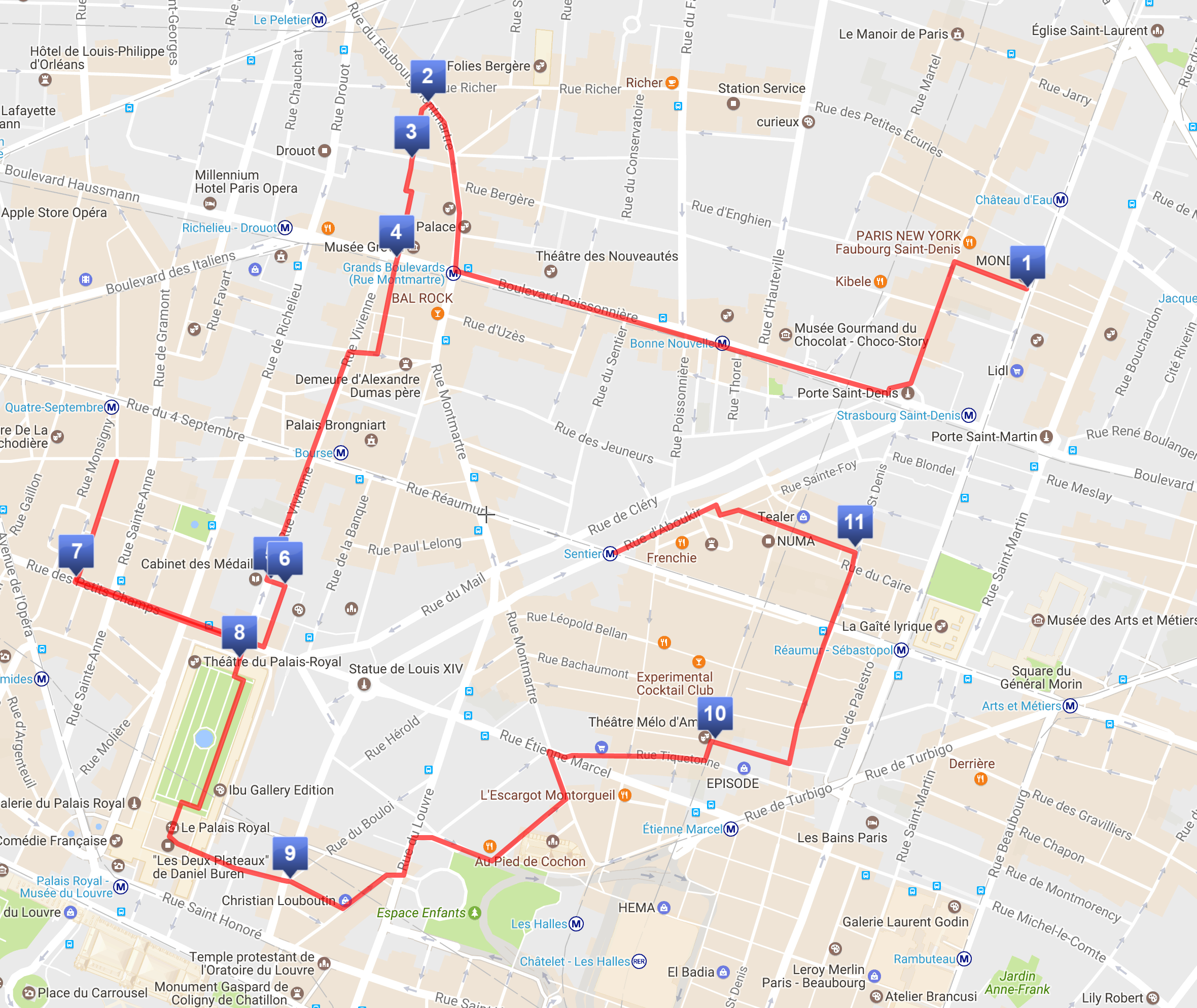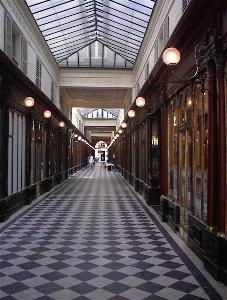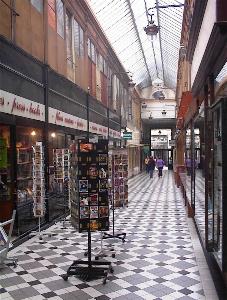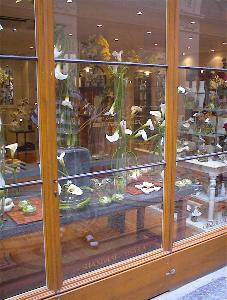Walking through the Arcades of Paris |
 |
|
In the 19th century Arcades were built in Paris
around the Grands Boulevards which had to protect shoppers from the mud
and dirt, w
We start our walk at the Passage Brady (1). This is the
centre of "Little India" in Paris with shops and eateries, which would make you think that you have landed in India itself. We
walk from subway station Chateau d'Eau into the arcade from Boulevard de Strassbourg
(at nr. 33). This arcade is not exactly exemplary for what is still to
come. The arcade is slightly run down and does not look Parisian at
all. Still it is a special experience: it is a total escape from Paris.
Around Boulevard de
Strassbourg are a few more arcades of lesser significance (Désir, Reilhac,
de L'Industrie, Prado and du Marché). We leave Passage Brady and walk left into Rue du Faubourg de St Denis . This is a lively street full of butcher shops and groceries. At the end the street is spanned by the Porte
St-Denis, an arch of triumph in honour of Louis XIV victories in We continue our route turning right into Boulevard St Denis which continues as Bd de Bonne Nouvelle. The shops here are nothing special. We turn right after some 700 metres into Rue de Faubourg de Montmartre. On our left at no. 7 we find the restaurant Chartier.
This traditional 19th century soup kitchen is a landmark in Paris. If
you are after a quick, cheap and reasonably good meal in historic
surroundings and are not bothered about sharing a table, this is your
place to be. We cross Rue de la Grange Bateliere and enter Passage de Jouffroy
(3). This arcade was opened in 1846 is constructed in exclusively out
of steel and glass. In this arcade you can buy walking canes (Segas brothers)
and theatrical props. In addition to that there is ashop selling
any piece of furnature imaginable to furnish a doll house. There
is the romantic looking hotel Chopin and film buffs will like We cross the Boulevard Montmartre and go into Passage des Panoramas
(4). This arcade is one of the oldest in Paris (1799). It is much
busier and actually a maze of a number of connecting arcades (GaleriesVarieté, St Marc en Montmartre).
Emile Zola wrote about it in his novel Nana. It is lacking in nice
tiles on the floor and the restaurants are not too enticing, with the
exception of Canard et Champagne,
with its beautiful wooden panelling. Other than that you will find lots
of bric a brac shops selling post stamps, rubber stamps and other
collectable items. We leave the arcade at de Rue St Marc. We cross this street veering to the right and then turning left into Rue Vivienne. This street leads us along the stock exchange (bourse). We continue along rue Vivienne crossing rue de la Bourse, rue 4 Septembre and finally rue Colbert. On our left hand side we ultimately find near no. 6 the entrance to Galeries Vivienne and Colbert (5). The Galerie Colbert is owned by the Bibliotheque Nationale (National Library) across the street and connects rue Vivienne with rue des Petits-Champs. In the Galerie Colbert you will find free exhibitions of parts of the Library's collection. The arcade is very luxuriously decorated and holds Brasserie in 1830s style, Le Grand Colbert, where head librarians and wealthy academics retire for lunch. In the Galerie Vivienne next is a flag ship store of Jean Paul Gaultier, always good for brief adorating look at unaffordable haut-couture.
|
 hich
was caused by the traffic. For decades these shopping malls avant la
lêtre were ignored. In recent years, they were renovated again and form
an oasis of quiet, protected from the much greater dangers of modern
traffic. Of the 100 passes of yesteryear, about 20 have survived
20. However, the arcades have not fallen into the hands of the large
chains and corporations. In the passages there is still room for quirky
shops, which you thought would have disappeared long ago. The passages
are very different in character, from indian eateries to haute couture,
stamps to interior decorating. We made a walk along 9 of the still
remaining arcades.
hich
was caused by the traffic. For decades these shopping malls avant la
lêtre were ignored. In recent years, they were renovated again and form
an oasis of quiet, protected from the much greater dangers of modern
traffic. Of the 100 passes of yesteryear, about 20 have survived
20. However, the arcades have not fallen into the hands of the large
chains and corporations. In the passages there is still room for quirky
shops, which you thought would have disappeared long ago. The passages
are very different in character, from indian eateries to haute couture,
stamps to interior decorating. We made a walk along 9 of the still
remaining arcades. At Rue de
Provence we see the entrance to the Passage
Verdeau (2)
At Rue de
Provence we see the entrance to the Passage
Verdeau (2)  Ciné-Doc a book shop specialising in books on movies. Near the exit on to Boulevard Montmartre you will find a wax museum called
Ciné-Doc a book shop specialising in books on movies. Near the exit on to Boulevard Montmartre you will find a wax museum called 